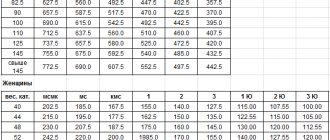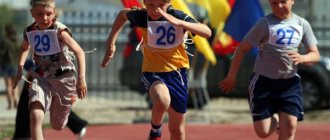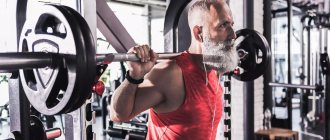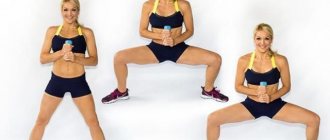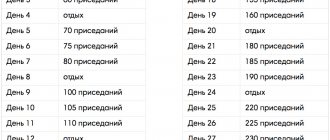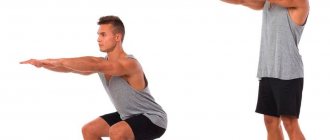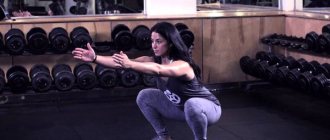IPF Powerlifting Class Standards
According to the IPF Federation, sports titles are awarded from the following ages:
Read also: If the minced meat has a smell, what should you do?
- MSMK (master of sports of international class) - the title is awarded from the age of 17;
- MS (Master of Sports) - the title is awarded from the age of 16;
- Sports categories (I, II, III, Candidate Master of Sports) are awarded from the age of 10.
MSMK title
assigned:
- At sports competitions that have a status no lower than other international sports competitions included in the EKP.
- Subject to doping control and the presence of three sports judges of at least the All-Russian category on the platform.
MS title
assigned:
- At competitions not lower than the status of other all-Russian sports competitions included in the ECP, championships of the federal districts of the Russian Federation, zonal qualifying competitions, championships in Moscow and St. Petersburg.
- Subject to random doping control and the presence of three sports judges of at least the All-Russian category on the platform.
Title of Candidate of Masters
assigned:
- At sporting competitions the status of a subject of the Russian Federation is not lower and there are two sports judges not lower than the All-Russian category on the platform.
Bench ranks AWPC
Barbell hack squats
Qualifying for this exercise can be done in combination with two more. If you add deadlifts and squats to the bench press, you get a full-fledged powerlifting competition. The method of conducting such competitions is as follows: three approaches are performed, one repetition in each of them. Three attempts are given to the athlete in order to provide him with the opportunity to cope with a large weight, according to which the AWPC (bench press) ranks will be assigned.
An exercise in this federation has lower criteria for obtaining a qualification category, for example, a candidate for master of sports. So, with 52 kg, it is necessary to perform the exercise only with a projectile of 82.5 kg, and not 97.5 kg, as required in other organizations.
It is also worth noting that both men and women can take part in these competitions. The female half, naturally, has its own standards for receiving any category. To receive the title of Master of Masters, for example, an athlete weighing 52 kg must perform an exercise with an apparatus weighing 82.5 kg. Women's competitions are held separately from men's. By the way, each federation has its own requirements for performing the bench press.
Sports equipment for powerlifting
Powerlifting equipment can be of two types: supportive and non-supportive. The second is allowed in all competitions, but usually equipment is understood as the type that supports it, which consists of the following elements:
- a belt for powerlifting (weightlifting) or a wide belt for triathlon;
- tights for powerlifting (wrestling) made of elastic material;
- a T-shirt with sleeves or a special T-shirt;
- powerlifting knee wraps;
- weightlifting shoes – special shoes;
- gaiters, shin guards or gaiters.
Also acceptable:
- special shoes for squats and deadlifts;
- neoprene knee pads;
- wrist bandages;
- special overalls.
The main purpose of support equipment is to protect the athlete from injury. It is designed to reduce stress on the muscles and allow the athlete to maintain the correct position.
Read also: Online photo editor hair color
Discharger, master, elite. Compare deadlift, bench press, squat with powerlifter standards
How much do you bench? Do you squat? Are you pulling? These questions are asked most often in the room. “Soviet Sport” suggests comparing your strength with the standards of dischargers, candidates for master of sports, masters and elite powerlifting - and understand that the path to perfection is thorny and long.
Standards. What are there
Standards in powerlifting (powerlifting) may vary depending on the federation, and there are about a dozen of them in Russia. Some of them calculate the standards “the old fashioned way,” namely, adding up the total amount of kilograms lifted in three movements: squat, deadlift and bench press. This is done, for example, by the Russian Powerlifting Federation (RFF), one of the largest in the country.
Other federations may “split” the standards and allocate separate ones for each of the competitive movements. This is what the AWPC/WPC Powerlifting Organization does, which, moreover, divides the standards depending on whether the athlete lifted weights with or without equipment.
To make it easier to compare our strengths with the powerlifting elite, we chose the categories without equipment. That is, athletes benched, squatted and pulled in much the same way as you do in the gym - without special overalls, often multi-layered, wristbands and wrist straps. The most they had on were weightlifting belts and ordinary neoprene knee pads.
Deadlift
If you are a man weighing up to 82.5 kg, you should deadlift with a weight of 102.5 kg. This will give you the right to receive a second youth rank. Did it seem easy? Go ahead.
For the 1st youth category you need to pull 127.5 kg. And in order to move to the adult standard, you need to do deadlifts with a weight of 152.5 kg (3rd adult category), 177.5 (2nd adult) and 197.5.
If you have overcome the last tonnage, congratulations! You are a first-class!
Train like a Crips gang leader
However, the most interesting thing is yet to come. To pass the KMS standard, you need to pull 222.5 kg, for MS - 255, for MSMC - 292.5 kg. You are one step away from the elite! Now put a weight on the barbell equal to 330 kg and pull as hard as you can. Happened? Now big bearded guys like Kirill Sarychev will consider you one of their own.
It is necessary to clarify that as your own weight increases, the kilograms of the standards also increase. So, if your weight is 90 kg, then for youth categories you will already need to take 105 and 132.5 kg in the deadlift (for 2nd and 1st youth categories). The 3rd adult category will cost you 160 kg (and not 152.5 as in the previous weight category). 2nd adult - 185 kg, and 1st category - 207.5 kg deadlift.
Bench press
The bench press is one of the favorite exercises among visitors to the gym (unlike squats and deadlifts, which are considered more difficult - including psychologically difficult).
To achieve success in the raw bench press, the average man weighing 82 kg needs to lift: 87.5 kg for the 3rd adult level, 102.5 kg for the 2nd adult level, 112.5 kg for the 1st adult level.
KMS will cost you 127.5 kg, MS - 145 kg, MSMK - 167.5 kg. Want to go even further? The title of “elite” will be yours if you bench press 192.5 kg.
As with the deadlift, the heavier your bodyweight, the more you need to press. If you weigh 90 kg, you should lift 92.5 kg for 3rd adult, 107.5 for 2nd adult, 120 kg for 1st adult. You will get the CMR if you bench press 132.5 kg, MS – 152.5 kg, MSM – 175 kg. The 90-kilogram “elite” bench presses from 202.5 kg.
Dont be upset! Perhaps you will like women's standards more. “Elite” among women weighing 75 kg must bench press “only” 107.5 kg, MSM – 92.5 kg, MS – 80 kg, CMS – 70 kg. Go for it!
Squats
Male amateurs without equipment who have passed doping control must squat for categories as follows: if your weight is 82.5 kg - 97.5 kg for 2nd youth category, 107.5 kg for 1st youth category, 125 for 3rd adult category, 147.5 for 2nd adult category, 180 for 1st category adult.
“Elite” in this weight class squats from 267.5 kg, MSMK - from 240 kg, MS - from 207.5, KMS - from 197.5 kg.
Compare your strength with the standards of the world's elite army units
With a weight of 90 kg, the task becomes more complicated: 115 kg for 1st youth category, 135 kg for 3rd adult, 157.5 for 2nd adult, 190 - to become a first-class. If that's not enough, try doing a squat with a monstrous 210 kg on your shoulders, or a MC with 222.5 kg. “Elite” in this weight squat with a barbell of 285 kg.
Women (whose standards will probably again seem more realistic to you) squat from 110 kg to pass the 2nd category, from 122.5 - to get the 1st, from 140 kg - to become Master of Masters, from 157.5 - to take MS, 177.5 - MSMC . The elite are those who squat with at least 215 kg on their shoulders with a body weight of 75 kg.
Notes
You might feel sad when you compare your strength to that of amateur powerlifters.
Do not despair! Many federations use very fragmented doping control in competitions, and powerlifting itself is often accused of the dominance of “chemists” - athletes who, in order to achieve results, resort to sports (and not always legal) pharmacology.
Unlike them, you swing “in nature”. All your results are your own, earned through hard work, not doping. Let this warm your heart, just like your last brutal bench press of 80 kg - the video of which proudly hangs on your Instagram to the envy of your friends.
The materials were based on the standards of the federations IPA-A, AWPC, IPF.
Source: https://sport.rambler.ru/other/36535109-razryadnik-master-elita-sravni-tyagu-zhim-prised-s-normativami-pauerlifterov/
Types of squats
These variations are performed to work the muscles more deeply, or to work on the weak points of the power movement in powerlifting.
Frontal
The barbell is held on the chest, a clear approach is required. The body cannot tilt forward.
Zerchera
The barbell is held by bending the elbow, at waist level. The movement serves to correct excessive forward lean in the classic barbell squat.
What muscles work?
This type of exercise is multi-joint basic, that is, during training, several muscle groups develop at once. If we consider the classic version, then the target load falls on the quadriceps and quadriceps muscles.
As synergists - the muscles of the buttocks, adductors and soleus muscles. Dynamic stabilizers - muscles of the back of the thighs, calf muscles, stabilizers - spinal extensors, antagonist-stabilizers - rectus/oblique abdominal muscles. If you vary your technique, the load on different muscle groups will change.
How to squat correctly for a man to avoid damaging his knees?
If there are no injuries to the knee joint and the exercises are performed correctly, you don’t have to think about the risk of damaging your knees. However, you should still adhere to the following rules:
- The weight of the barbell is selected taking into account the exercises performed. Do not increase the load and pace to the maximum. Before starting exercises, take time to warm up and stretch your muscles.
- The exercises are performed smoothly, without jerking. Sudden movements are not allowed.
- For maximum load on the legs and muscles, the squat is performed to a right angle.
BENCH PRESS
The bench press bench must be of sturdy construction and provide maximum stability, and must meet the following requirements:
a).
The length should not be less than 1.22 m. The bench should be smooth and positioned strictly horizontally.
b).
The width should not be less than 29 cm and should not exceed 32 cm.
c).
The height should not be less than 42 cm and should not exceed 45 cm. The height is measured between the floor and the top of the padded surface of the bench, and the padded surface should not be compressed or stretched in any way.
d).
The height of the legs of an adjustable bench must be a minimum of 82 cm and a maximum of 100 cm. The height of the legs of a non-adjustable bench must be a minimum of 87 cm and a maximum of 100 cm. This height is measured between the floor and the bar that is on the posts.
e).
The minimum width between bench posts should be 1.10 m.
Barbell squats, deadlifts. FPR standards
People consistently come to one of my sites from search engines for the query “standard barbell squats” or “standard deadlifts.” The fact is that there are no such standards, at least not current ones.
Nowadays, sports categories and titles are assigned based on the result of the sum of three exercises. But earlier, from 1988 to 1997. a sports category was assigned only when the standard was met in each individual exercise.
| Weight category, kg | Exercise | Sports category | |||||
| MS | KMC | I | II | III | I junior | II junior | |
| 52 | Press | 102.5 | 95.0 | 85.0 | 70.0 | 57.5 | |
| Squat | 135.0 | 127.5 | 117.5 | 100.0 | 77.5 | ||
| Traction | 140.0 | 132.5 | 120.0 | 107.5 | 45.0 | ||
| Sum | 440.0 | 402,5 | — | — | — | — | — |
| 56 | Press | 110.0 | 102,5 | 92.5 | 77.5 | 62.5 | |
| Squat | 147.5 | 140.0 | 127.5 | 107,5 | 85.0 | ||
| Traction | 1500. | 142.5 | 130.0 | 117.5 | 92.5 | ||
| Sum | 477.5 | 435.0 | — | — | — | — | — |
| 60 | Press | 117.5 | 110.0 | 100.0 | 82.5 | 67.5 | |
| Squat | 157.5 | 150.0 | 135.0 | 115.0 | 92.5 | ||
| Traction | 162.5 | 155.0 | 140.0 | 125.0 | 100.0 | ||
| Sum | 512.5 | 467.5 | — | — | — | — | — |
| 67.5 | Press | 130.0 | 122.5 | 110.0 | 90.0 | 75.0 | |
| Squat | 175.0 | 165.0 | 150.0 | 130.0 | 102.5 | ||
| Traction | 180.0 | 170.0 | 157.5 | 140.0 | 110.0 | ||
| Sum | 570.0 | 520.0 | — | — | — | — | — |
| 75 | Press | 142.5 | 132.5 | 120.0 | 100.0 | 80.0 | |
| Squat | 190.0 | 180.0 | 165.0 | 140.0 | 110.0 | ||
| Traction | 195.0 | 185.0 | 170.0 | 152.5 | 120.0 | ||
| Sum | 620 | 565.0 | — | — | — | — | — |
| 82.5 | Press | 152.5 | 142.5 | 127.5 | 105.0 | 87.5 | |
| Squat | 202.5 | 192.5 | 175.0 | 150.0 | 117.5 | ||
| Traction | 210.0 | 197.5 | 182.5 | 162.5 | 127.5 | ||
| Sum | 660 | 602.5 | — | — | — | — | — |
| 90 | Press | 160.0 | 147.5 | 135.0 | 110.0 | 90.0 | |
| Squat | 212.5 | 202.5 | 185.0 | 157.5 | 125.0 | ||
| Traction | 220.0 | 207.5 | 190.0 | 170.0 | 135.0 | ||
| Sum | 692.5 | 632.5 | — | — | — | — | — |
| 100 | Press | 167.5 | 155.0 | 142.5 | 117.5 | 95 | |
| Squat | 222.5 | 212.5 | 192.5 | 165 | 130 | ||
| Traction | 230.0 | 217.5 | 200 | 180 | 142.5 | ||
| Sum | 727.5 | 665.0 | — | — | — | — | — |
| 110 | Press | 172.5 | 160.0 | 147.5 | 120.0 | 97.5 | |
| Squat | 230.0 | 220.0 | 200 | 170.0 | 135.0 | ||
| Traction | 257.5 | 225.0 | 207.5 | 185.0 | 147.5 | ||
| Sum | 752.5 | 687.5 | — | — | — | — | — |
| 125 | Press | 177.5 | 165.0 | 150 | 122.5 | 100.0 | |
| Squat | 235.0 | 225.0 | 205 | 175.0 | 137.5 | ||
| Traction | 242.5 | 230.0 | 212.5 | 190.0 | 150.0 | ||
| Sum | 767.5 | 700.0 | — | — | — | — | — |
| + 125 | Press | 180.0 | 167.5 | 152.5 | 125.0 | 102.5 | |
| Squat | 240.0 | 227.5 | 207.5 | 177.5 | 110.0 | ||
| Traction | 247.5 | 235.0 | 215 | 192.5 | 152.5 | ||
| Sum | 782.5 | 715.0 | — | — | — | — | — |
Conditions for fulfilling the discharge standards:
1. Fulfillment of the MS and KMC standards for the sum of three exercises, but in each exercise the result must not be lower than the I category standard.2. Compliance with standards of categories I - III - based on results in each movement.3. The title “Master of Sports of the USSR” is awarded only at competitions held by the State Committee for Sports of the USSR, and at championships and cups of the Union republics.
National bench press programs
Since the folk bench press is slightly different from the usual sports activity, the training needed, accordingly, is different. Over the eight years that this sport has been developing, many different programs have appeared from record holders and finalists of various competitions. Based on their results, we can judge that these schemes are working, so let's look at them in a little more detail.
Training methodology - Luchkov Andrey
Andrey is a master of sports of international class WPC, who has set several current records. Today he is 52 years old and continues to perform.
His training plan consists of two workouts per week, one of which is dedicated to the folk press.
This type of training begins with a good warm-up, followed by three sets of bench presses. The weight is fixed, just like in competitions. The goal is to do the most reps
At the same time, the athlete emphasizes that it is important to rest well between approaches for 5–10 minutes. Andrey writes down the resulting amount to control changes.
The second training takes place according to a different scenario.
For the bench press, there is only one approach, and it is important to work out a specific technique, for example, squeezing with rest at the top point
After the bench press approach is done, Andrey carefully works the triceps and pectoral muscles with a small weight, but for a large number of repetitions.
This is what one week of training looks like. The goal of each subsequent week is to increase the amount of repetitions. This is quite easy at first, as you can increase the number of repetitions in the second and third sets. When it is not possible to do more, Andrey loads the barbell with heavier weight and repeats the program from the beginning.
Video: Barbell press 150kg x 21 times, Luchkov Andrey
- The first stage is preparation, which includes both strength and general development exercises. This stage can last about two months. It improves the athlete’s performance, improves technique and works on mistakes.
- The second stage is competitive. The intensity of training is of greatest importance.
- The third stage is recovery, it takes place after the competition, at which time the athlete’s loads are briefly reduced.
Judging
1.
There must be three judges: a senior (central) judge and two side judges.
2. The Chief Judge is responsible for giving the necessary signals in all three exercises.
3. The signals for the three exercises are presented in the following table.
4. At the end of the exercise, as soon as the bar is returned to the racks or lowered onto the platform, the judges announce their decision by means of a light signal. In this case, the white light corresponds to the decision “good lift” (“the weight is taken”), and the red light corresponds to the decision “no lift” (“the weight is not taken”).
5. Three judges are located in such a place near the platform that they consider the most convenient for viewing in each of the exercises.
| Exercise | Start | Ending |
| Squat | A visible signal consisting of a downward movement of the hand, along with the audible command “squat” | |
| Bench press | A visible signal consisting of a downward movement of the hand, together with an audible command "start" ("start") | A visible signal consisting of a backward movement of the hand, along with the distinct command “rack” (“on the racks”) |
| Traction | No signal required | A visible signal consisting of a downward movement of the hand, together with the audible command "down" ("down") |
The Chief Judge must always remember to be in full view of the lifter performing the squat or deadlift.
Bench press without equipment
There are several organizations on the territory of the Russian Federation that hold their own, separate competitions in such a strength sport as the bench press. The official branch of the international powerlifting organization (IPF) in Russia is the FPR - Russian Powerlifting Federation. Besides it, there are several more, such as WPO/WPC. A notable difference between these organizations is that they conduct their bench press competitions without prior drug testing. However, this does not in any way affect the required results. In order to receive ranks in the bench press without equipment, let's say, master class, you need to perform the exercise with the same apparatus of 97.5 kg with the same body weight of 52 kg.
Powerlifting Squat Standards
The number one program in powerlifting is the squat. For many lifters, this exercise is the most favorite, since with the correct technique of setting and performing it allows you to take maximum weights.
Many famous powerlifters, such as Kirk Karwoski, Mike Bridges, while remaining mediocre athletes in the deadlift and bench press, easily won major competitions precisely thanks to the correct squat. Thus, the conclusion is that without having a good squat it is practically impossible to become a champion.
How to train a squat in powerlifting? In Russia there are two fundamentally different main schools: Vladimir and Moscow. The first trains squats every other day, while the second trains according to the scheme squat - press - deadlift - press - squat, that is, the muscle group focused on squats has time to fully recover before the next load.
There are two possible solutions to the squat technique: either you swing your legs to incredible sizes, or you learn how to perform this exercise correctly. If you plan to lift maximum weights in the future, then your choice should be in favor of the second option. In addition, refuting the myth that squats with weights are harmful to the knees, I will say that performing this exercise correctly strengthens the knees.
Fans of powerlifting have probably observed a similar situation many times: the lifter removes the barbell and begins to “dance” with it. This takes an incredible amount of strength, which simply may not be enough for the main exercise. Avoid unnecessary fuss in performing the squat.
It is important to remove the barbell from the racks correctly and find its normal position on your back. In this case, the bar should not lie too high on the trapeze
Then place your feet in line with the bar and move your diaphragm forward slightly.
The movement of the legs to remove the bar should be strong, but smooth enough so as not to damage the spine. If you use a narrow position of your legs in a squat, then when you step away you will need to take two steps, but if your technique involves using a wide position of your legs, then there will be three steps.
There is a technique for training squats on a platform. This is the safest method because it uses minimal weights and allows for faster recovery.
Many lifters use special bandages and suits, thereby somewhat changing the normal biomechanics of human movements. The squat technique is such that it allows maximum use of muscle resistance to bandages and the suit.
Another important secret in performing a squat is its speed of execution. You should squat as quickly as possible, but adhering to the principle of equal acceleration. The secret is that with this technique you relieve the body of the need to use the entire supply of adenosine triphosphoric acid (ATP) and do not give the judges the opportunity to see the full angle.
Performance standards are developed depending on a person’s abilities at a certain time and the general level of development of athletes. The latest standards were developed and approved in 2012. Standards are derived separately for men and women in different ages and weight categories.
What is a folk bench press?
The essence of the folk press is that athletes squeeze a barbell while lying on a bench, but in this case their task is not to lift the maximum weight, but to do the maximum number of repetitions per approach. The weight of the barbell is equal to the weight of the athlete himself, who is weighed a day before the competition.
For girls and boys 13–19 years old, the weight of the equipment can optionally be equal to half the athlete’s body weight.
When performing the exercise, the athlete can rest for no more than 5 seconds, holding the squeezed barbell with outstretched arms.
wpc and awpc standards
Standards of the World Powerlifting Congress (wpc) - a non-profit international organization of powerlifters, uniting 30 member states.
With its own weight
There are separate standards for the category of athletes 13–19 years old.
With 1/2 of your weight
Standards of the Amateur World Powerlifting Congress (AWPC) - an amateur league, the standards of which are much softer, but at the same time there is doping control at competitions.
With its own weight
The AWPC also sets separate standards for working with half an athlete's body weight.
With 1/2 of its own weight
Records
I would like to note several records.
WPC Records:
- Among boys under 19 years of age, we can note Maxim Chursanov, who set a record with a weight of 60 kg, squeezing the barbell 51 times in 2016 at the World Championships.
- Among the men, Silkin Alexander distinguished himself, who at the Russian Championship in 2016 pressed the weight of the barbell 112.5 kg 42 times.
- At the 2016 World Championships, Anastasia Chernousova set a record, pressing ½ of her body weight (25 kg) 52 times.
AWPC Records:
- At the 2022 World Cup, Nikita Sizonov, who was only 15 years old, set a record of 49 repetitions with 27.5 kg (½ weight).
- Among girls under 19 years old at the World Championships in 2016, Natalya Markushina set a record by pressing a barbell 40 times weighing 30 kg (½ her own weight).
- At the Asian Cup in 2016, Evgeniya Chekanova distinguished herself in the age category of 40–49 years, setting a record of 42 repetitions with a projectile weight of 32.5 kg.
Multi-repetition bench press technique
Before describing the training programs directly, let's look at the technique of the most high-repetition barbell press, adjusted for the division rules.
For a repetition to be counted in competition, you must work in full amplitude: touching your chest at the bottom and fully straightening your arms at the top.
Technique:
- You need to lie on a horizontal bench on your back, with your shoulder blades, shoulders and buttocks pressed tightly to the surface. You cannot lift your pelvis off the bench while performing the exercise.
- The feet should also not be completely lifted off the floor or touch the bench in any way.
- The bar should be in front of your eyes.
- At competitions, at least two people provide insurance. The spotters can be asked to help remove the barbell; in this case, it will be held at outstretched arms.
- If you want to lift the bar yourself, use a closed grip to hold the bar. You can use a forward or reverse grip. The distance between hands should not exceed 81 cm.
- After removing the bar from the racks, exhale and bring it to your outstretched arms above your chest.
- After this, you can start doing the exercise. At competitions, this is permissible to do only after the senior judge’s command to “press.”
- As you inhale, lower the barbell until the bar touches your torso. As you exhale, squeeze out.
- In competition you will only have one approach.
- The judge will count the number of repetitions. If the countdown starts again, it means that an error was made in the previous repetition.
- You can rest with the barbell on your arms, as we noted earlier, for no more than 5 seconds. The judge monitors this and, after time has expired, repeats the command “press” again. If the command fails, the approach is terminated.
The athlete must wear a non-supportive single layer tights. It is acceptable to use a belt to protect the lower back. Socks are allowed. The athlete must also wear shoes. If necessary, you can use bandages or wristbands for your hands.
TABLE OF DIFFERENT STANDARDS FOR WOMEN
1. DC push (number of weight lifts in 10 minutes)
| Weight category (kilogram) | MSMK kettlebell 24kg | MS kettlebell 24kg | KMS kettlebell 24kg | I weight 16kg | II kettlebell 16kg | III kettlebell 16kg |
| 63 | 59 | 44 | 35 | 60 | 49 | 39 |
| 63+ | 72 | 56 | 45 | 65 | 54 | 43 |
2. Snatch (number of weight lifts in 10 minutes)
| Weight category (kilogram) | MSMK kettlebell 24kg | MS kettlebell 24kg | KMS kettlebell 24kg | I weight 16kg | II kettlebell 16kg | III kettlebell 16kg | I(u) kettlebell 16kg | II(u) kettlebell 16kg | III(u) kettlebell 16kg |
| 48 | — | — | — | 80 | 60 | 45 | 43 | 33 | 23 |
| 53 | — | — | — | 90 | 70 | 50 | 45 | 35 | 25 |
| 58 | — | — | — | 100 | 80 | 60 | 55 | 45 | 35 |
| 63 | 159 | 126 | 73 | 110 | 90 | 70 | 65 | 55 | 45 |
| 63+ | 181 | 146 | 86 | 125 | 100 | 85 | 75 | 65 | 55 |
CONVENTIONAL ABBREVIATIONS:
MSMK
- Master of Sports of International Class MS
- Master of Sports
Master
- Candidate for Master of Sports
I
- first category
II
- second category
III
- third category
I(u)
- first youth category
II(u)
- second youth category
III(u)
- third youth category
CONDITIONS FOR COMPLIANCE WITH STANDARDS:
| 1. | The tables show the number of lifts in 10 minutes, for sports disciplines the names of which contain the word “biathlon” - the number of points scored in 10 minutes in each exercise. |
| 2. | Sports disciplines whose names contain the word “biathlon” consist of a “jerk” exercise and a “snatch” exercise. |
| 3. | Points in sports disciplines whose names contain the word “both-event” are awarded: 1 clean and jerk - 1 point, 1 snatch - 0.5 points. |
| 4. | The sports title of master of sports of international class (MSMK) is awarded for fulfilling the norm when taking 1-2 places at the World Championships, 1 place at the European Championships, 1 place at the World Cup, 1 place at the European Cup, 1 place at the World Championships among juniors and junior women (19-22 years old), 1st place at the European Championship among juniors, juniors (19-22 years old), 1st place at other international sports competitions included in the EKP, held according to the World Cup regulations. |
| 5. | To be awarded the MSMC, it is necessary to carry out doping control at the specified sporting competitions. |
| 6. | The sports title of master of sports (MS) is awarded for fulfilling a standard at sports competitions not lower than the status of other all-Russian sports competitions included in the EKP. |
| 7. | The sports title of Candidate Master of Sports (CMS), I sports category is awarded for fulfilling standards at sports competitions not lower than the status of other official sports competitions of a constituent entity of the Russian Federation. |
| 8. | II-III sports categories are assigned for fulfilling standards at sports competitions not lower than the status of other official sports competitions of the municipality. |
| 9. | I-III youth sports categories are assigned for fulfilling standards at other official sports competitions of any status. |
| 10. | Russian championships, all-Russian sports competitions included in the EKP, among persons with an upper age limit, championships of a federal district, two or more federal districts, championships of a constituent entity of the Russian Federation, other official sports competitions of a constituent entity of the Russian Federation among persons with an upper age limit, championships municipal formation, other official sports competitions of the municipal formation among persons with an upper age limit are held in age groups: juniors, juniors (19-22 years), boys, girls (17-18 years), boys, girls (14-16 years) . |
Bench press
We continue to consider AWPC standards. The bench press requires the following equipment: wrist bandages and a T-shirt (shirt).
Here's what the standards for this exercise look like if you don't use equipment:
Multi-layer equipment implies an increase in parameters:
When competing in single-layer equipment, the numbers are also slightly different:
The information in the tables changes periodically. The article provides the latest data, which was approved in 2012.
https://vk.com/topic-8637134_32897119https://fitness-page.ru/rossiiskaya-federaciya-pauerliftinga-raznica-mezhdu-awpc-i-wpc-oborudovanie-i-ego.htmlhttps://fb.ru/ article/150385/otlichiya-awpc-i-wpc-normativyi-awpc
Standards for squats with a barbell of the SPR and NAP federations
SPR - Union of Russian Powerlifters. NAP - National Powerlifting Association. The tables below present data for these two federations simultaneously (all data assumes no equipment).
A search for data on standards for the IPF federation did not give us results, and brought us to the data of the above federations on the website.
Men
| Weight category | Federation | MSMK | MS | KMS | I category | II category | III category |
| 52 kg | SPR | 162.5 | 140 | 120 | 102.5 | 92.5 | 77.5 |
| NAP | 155 | 135 | 127.5 | 115 | 97.5 | 82.5 | |
| 56 kg | SPR | 175 | 150 | 130 | 112.5 | 102.5 | 85 |
| NAP | 165 | 145 | 135 | 122.5 | 105 | 87.5 | |
| 60 kg | SPR | 187.5 | 160 | 137.5 | 120 | 107.5 | 92.5 |
| NAP | 177.5 | 155 | 147.5 | 132.5 | 112.5 | 92.5 | |
| 67.5 kg | SPR | 207.5 | 180 | 155 | 135 | 122.5 | 102.5 |
| NAP | 202.5 | 175 | 167.5 | 147.5 | 125 | 105 | |
| 75 kg | SPR | 222.5 | 192.5 | 167.5 | 145 | 132.5 | 112.5 |
| NAP | 225 | 195 | 185 | 165 | 135 | 115 | |
| 82.5 kg | SPR | 235 | 205 | 175 | 152.5 | 140 | 117.5 |
| NAP | 240 | 207.5 | 197.5 | 180 | 147.5 | 125 | |
| 90 kg | SPR | 247.5 | 215 | 187.5 | 162.5 | 147.5 | 125 |
| NAP | 257.5 | 222.5 | 210 | 190 | 157.5 | 135 | |
| 100 kg | SPR | 260 | 225 | 195 | 170 | 155 | 132.5 |
| NAP | 272.5 | 237.5 | 225 | 202.5 | 170 | 142.5 | |
| 110 kg | SPR | 267.5 | 232.5 | 200 | 175 | 160 | 137.5 |
| NAP | 285 | 250 | 232.5 | 205 | 172.5 | 150 | |
| 125 kg | SPR | 280 | 242.5 | 210 | 185 | 170 | 145 |
| NAP | 302.5 | 265 | 242.5 | 215 | 180 | 157.5 | |
| 140 kg | SPR | 287.5 | 250 | 217.5 | 190 | 175 | 150 |
| NAP | 315 | 272.5 | 245 | 217.5 | 182.5 | 165 | |
| 140+ kg | SPR | 295 | 255 | 222.5 | 195 | 180 | 155 |
| NAP | 320 | 277.5 | 247.5 | 220 | 185 | 167.5 |
Women
| Weight category | Federation | MSMK | MS | KMS | I category | II category | III category |
| 44 kg | SPR | 95 | 80 | 67.5 | 60 | 52.5 | 40 |
| NAP | 100 | 87.5 | 77.5 | 70 | 60 | 55 | |
| 48 kg | SPR | 107.5 | 90 | 77.5 | 65 | 57.5 | 45 |
| NAP | 107.5 | 97.5 | 85 | 75 | 67.5 | 60 | |
| 52 kg | SPR | 115 | 97.5 | 82.5 | 72.5 | 62.5 | 50 |
| NAP | 117.5 | 105 | 92.5 | 82.5 | 72.5 | 65 | |
| 56 kg | SPR | 125 | 105 | 90 | 77.5 | 67.5 | 55 |
| NAP | 125 | 112.5 | 97.5 | 87.5 | 77.5 | 67.5 | |
| 60 kg | SPR | 130 | 112.5 | 95 | 82.5 | 72.5 | 60 |
| NAP | 132.5 | 117.5 | 105 | 92.5 | 80 | 72.5 | |
| 67.5 kg | SPR | 140 | 120 | 102.5 | 90 | 80 | 65 |
| NAP | 147.5 | 127.5 | 117.5 | 102.5 | 87.5 | 77.5 | |
| 75 kg | SPR | 150 | 127.5 | 107.5 | 95 | 82.5 | 67.5 |
| NAP | 160 | 137.5 | 122.5 | 110 | 95 | 85 | |
| 82.5 kg | SPR | 155 | 135 | 115 | 100 | 87.5 | 72.5 |
| NAP | 172.5 | 145 | 127.5 | 115 | 100 | 87.5 | |
| 90 kg | SPR | 162.5 | 137.5 | 117.5 | 102.5 | 90 | 75 |
| NAP | 182.5 | 157.5 | 140 | 125 | 105 | 95 | |
| 90+ kg | SPR | 167.5 | 142.5 | 122.5 | 107.5 | 92.5 | 77.5 |
| NAP | 185 | 162.5 | 150 | 135 | 110 | 97.5 |
Men
| Weight category | Federation | MSMK | MS | KMS | I category | II category | III category |
| 52 kg | SPR | 182.5 | 155 | 142.5 | 125 | 112.5 | 92.5 |
| NAP | 185 | 165 | 145 | 127.5 | 112.5 | 100 | |
| 56 kg | SPR | 197.5 | 170 | 152.5 | 135 | 120 | 102.5 |
| NAP | 200 | 177.5 | 157.5 | 137.5 | 122.5 | 107.5 | |
| 60 kg | SPR | 212.5 | 180 | 165 | 145 | 130 | 107.5 |
| NAP | 212.5 | 190 | 167.5 | 147.5 | 130 | 115 | |
| 67.5 kg | SPR | 235 | 200 | 182.5 | 160 | 142.5 | 120 |
| NAP | 235 | 210 | 185 | 162.5 | 145 | 127.5 | |
| 75 kg | SPR | 252.5 | 217.5 | 195 | 172.5 | 155 | 130 |
| NAP | 252.5 | 225 | 197.5 | 175 | 155 | 137.5 | |
| 82.5 kg | SPR | 267.5 | 230 | 207.5 | 182.5 | 162.5 | 137.5 |
| NAP | 267.5 | 237.5 | 210 | 185 | 165 | 145 | |
| 90 kg | SPR | 280 | 240 | 215 | 192.5 | 170 | 145 |
| NAP | 280 | 250 | 220 | 195 | 172.5 | 152.5 | |
| 100 kg | SPR | 292.5 | 252.5 | 225 | 200 | 177.5 | 150 |
| NAP | 292.5 | 262.5 | 230 | 205 | 180 | 160 | |
| 110 kg | SPR | 302.5 | 260 | 232.5 | 207.5 | 185 | 157.5 |
| NAP | 302.5 | 270 | 237.5 | 210 | 187.5 | 165 | |
| 125 kg | SPR | 315 | 270 | 242.5 | 215 | 192.5 | 162.5 |
| NAP | 315 | 280 | 247.5 | 220 | 195 | 172.5 | |
| 140 kg | SPR | 325 | 277.5 | 250 | 222.5 | 197.5 | 167.5 |
| NAP | 325 | 290 | 255 | 225 | 200 | 177.5 | |
| 140+ kg | SPR | 330 | 285 | 255 | 227.5 | 202.5 | 170 |
| NAP | 332.5 | 297.5 | 262.5 | 232.5 | 205 | 180 |
Women
| Weight category | Federation | MSMK | MS | KMS | I category | II category | III category |
| 44 kg | SPR | 112.5 | 95 | 80 | 70 | 62.5 | 50 |
| NAP | 115 | 102.5 | 90 | 80 | 72.5 | 62.5 | |
| 48 kg | SPR | 125 | 105 | 90 | 77.5 | 67.5 | 55 |
| NAP | 127.5 | 112.5 | 100 | 87.5 | 77.5 | 70 | |
| 52 kg | SPR | 135 | 115 | 97.5 | 85 | 75 | 60 |
| NAP | 137.5 | 122.5 | 107.5 | 95 | 85 | 75 | |
| 56 kg | SPR | 145 | 122.5 | 105 | 90 | 80 | 65 |
| NAP | 145 | 130 | 115 | 102.5 | 90 | 80 | |
| 60 kg | SPR | 152.5 | 130 | 110 | 97.5 | 85 | 70 |
| NAP | 155 | 137.5 | 120 | 107.5 | 95 | 85 | |
| 67.5 kg | SPR | 162.5 | 140 | 120 | 105 | 92.5 | 75 |
| NAP | 167.5 | 150 | 130 | 117.5 | 102.5 | 90 | |
| 75 kg | SPR | 172.5 | 147.5 | 125 | 110 | 97.5 | 80 |
| NAP | 177.5 | 157.5 | 140 | 122.5 | 110 | 97.5 | |
| 82.5 kg | SPR | 180 | 155 | 132.5 | 115 | 102.5 | 85 |
| NAP | 185 | 165 | 145 | 130 | 115 | 100 | |
| 90 kg | SPR | 187.5 | 160 | 137.5 | 120 | 107.5 | 90 |
| NAP | 192.5 | 172.5 | 150 | 132.5 | 117.5 | 105 | |
| 90+ kg | SPR | 192.5 | 165 | 142.5 | 125 | 112.5 | 95 |
| NAP | 202.5 | 180 | 157.5 | 140 | 125 | 110 |
Note: the website has a more detailed set of tables with data on standards in the IPA (IPA) and SPR federations. But they are slightly different from those above. We do not have reliable information about which ones are more correct.
Bench ranks AWPC
Qualifying for this exercise can be done in combination with two others. If you add deadlifts and squats to the bench press, you get a full-fledged powerlifting competition. The method of conducting such competitions is as follows: three approaches are performed, one repetition in each of them. Three attempts are given to the athlete in order to provide him with the opportunity to cope with a large weight, according to which the AWPC (bench press) ranks will be assigned.
An exercise in this federation has lower criteria for obtaining a qualification category, for example, a candidate for master of sports. So, with 52 kg, it is necessary to perform the exercise only with a projectile of 82.5 kg, and not 97.5 kg, as required in other organizations.
It is also worth noting that both men and women can take part in these competitions. The female half, naturally, has its own standards for receiving any category. To receive the title of Master of Masters, for example, an athlete weighing 52 kg must perform an exercise with an apparatus weighing 82.5 kg. Women's competitions are held separately from men's. By the way, each federation has its own requirements for performing the bench press.
Tips for implementation
Equipment
The barbell is the main attribute of such a squat. In the gym, you can use a frame to support you. But it is also worth paying attention to additional nuances:
- Shoes - sneakers will distribute weight across the entire foot and soften contact with the floor.
- Athletic belt - a hard leather belt with a buckle for high-quality resistance to the core muscles and fixation of the lower back.
- Knee pads – for fixing the knees.
- Wrist straps are an accessory for strengthening the fixation of the bar and reducing pain in the wrists and elbows.
Sets and reps
The number of repetitions and approaches depends on the task:
- For weight loss - more repetitions with short rest between sets and light weights (4-5 sets of 20 or more repetitions).
- For strength and mass - do an average number of repetitions, combining them with exercises on machines (4-5 sets of 10 repetitions).
